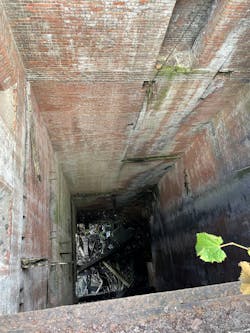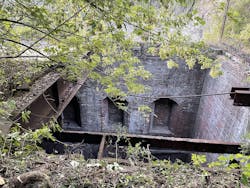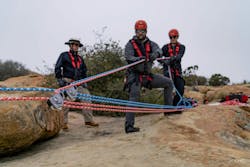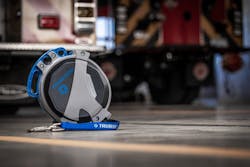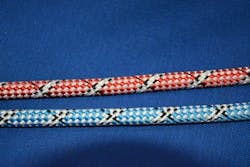Technical Rescue: How a Rope Rescue Team’s Changes Paid Off
As a crew leader, boss or officer, many points in one’s career stand out. Personally, it was quite powerful when one of my team members was on rope, connected to a litter basket, floating in air during a difficult recovery, and said to his partner below, “You know, all this BS training has really paid off.”
After the call, we critiqued each aspect of the operation, analyzing both the good elements as well as the things that needed improvement.
The safe and quick completion of that job was a testament to the importance of the recent changes that were implemented to our rope program by the department. The changes didn’t come from the top down or the bottom up but rather a combination of both, utilizing many levels of experience and training.
The victim
The call came in at about 2 a.m. for a person who fell down a hole. Initial access was from above from what was thought to be a cliff’s edge. The rope rescue team quickly found that they were on top of an old, concrete roof section that was 120 feet up. The roof section was covered in dirt and overgrown vegetation and only supported on three sides because of deterioration. The “hole” was, in fact, the result of a collapsed portion of the roof, which occurred many years prior. The building was part of an old hydroelectric plant that was located right next to a 100-foot waterfall that’s located on the Genesee River. There was one other opening for the building at the bottom at the river’s edge.
Early reconnaissance by the rope rescue team established the call to be a recovery. The victim was folded over a steel I-beam that was approximately 100 feet down a 20 x 20-foot void shaft and 20 feet off of the ground. Initial access needed to be from the top.
After members got out their headlamps and other lighting was established, the team began the task of establishing anchors. A 12-inch-diameter tree that was 30 feet off of the edge was used as the main anchor point. However, because of the tree’s shallow roots, it needed to be backed up. The belay required multiple anchors that were focused to one point that was close to the access point.
Communications
Communication issues became evident as the first rescuer was about to rappel over the edge. The team could deal with the dull roar of the waterfall. However, a 1½-mile-long commercial freight train that was passing 30 feet overhead on a trestle bridge was another challenge. Shutting down train traffic for a recovery wasn’t an option. We decided to continue operations and include a review of whistle commands. A quick blast from a whistle in the corner of a rescuer’s mouth could be heard from a great distance over the rugged terrain, trains, waterfall and machinery. Additionally, this gave the rescuer the ability to be hands-free and stopped the echo effect of commands being repeated until they were understood and acted on by the person at the descent-control device (DCD), the belay or the haul team. The verbal command “stop” requires the action that was taking place to stop immediately. A whistle blast is heard by all of the members at the same time.
From urban to rural settings, whistle blasts are a good alternative to push-to-talk radios and shouting.
The descent
A two-rope system consisted of a dedicated main and a separate (untensioned) belay.
The first rescuer rappelled down the main line through the use of a DCD to control his rate of descent.
The belay was established at the top, with a device fixed to a different anchor than that of the main line. The belay device that was selected could be used as either a traveling (with rescuer) belay or as a fixed (to anchor) belay. The technique of using it as a fixed belay was adapted only a few years prior by the department. The first rescuer was free to focus on his own descent and didn’t need to concern himself about his belay.
Once at the victim’s location, the first rescuer assessed the situation and ruled out a pickoff-and-lower maneuver because of the significant amount of used hypodermic needles at the bottom of the void shaft. The first rescuer requested an additional rescuer with a litter basket because of the position and size of the victim.
Victim removal would take a combination of rope rescue and rope-access techniques. Rope access teaches rope technicians a great deal of maneuverability and solo rescue techniques. The use of positioning lanyards as mechanical advantage in conjunction with other remote access skills to manipulate the victim into the basket were implemented without the need for additional ropes, equipment or team-based rescue maneuvers.
The ascent
After the victim was secured in the litter basket and was being hauled up, the second rescuer made his proclamation about “all this BS training.” It quickly was interrupted when the rope rescue officer at the top edge gave a suggestion to the second rescuer. He wanted the second rescuer to position himself between the litter basket and the connection point of the main and belay lines. The second rescuer, having recently trained on this maneuver, extended the distance between the main line connection and the litter basket using the adjustable litter system. The second rescuer’s new position gave him the ability to easily “walk” up the face of the void shaft to the 24-inch steel I-beam at the top transition.
Because of the location and lack of adequate anchors, the artificial high directional (AHD) setup didn’t completely clear the ropes of the I-beam. Once the second rescuer and litter basket were clear of the obstructions at the top, the second rescuer simply lowered himself enough to stand. With the second rescuer back with the team safely and the litter basket with the medical examiner, the first rescuer was hauled up, and the operation was complete.
Cause for change
A few of the operational changes that were made over the past few years to improve readiness included training in the dark, multipoint equalized anchor systems, alternative communications, rope-access techniques and nontraditional belays.
Who can suggest changes that are necessary to move a team forward? Any member who is associated with the group should be free to respectfully challenge the established system and permitted to offer possible changes, regardless of team size, to better themself and their teams.
Leaders (not necessarily those who are in charge either by rank or title) should assess operations constantly.
If the tools that we use and the techniques that we employ are of sound concept, they easily are defended. That said, the adage “Because we’ve always done it that way” should be alarming and a cause (dead giveaway) for immediate review.
Traditional methods, such as dedicated main and belay, have their value and place. New techniques should be tested and, if applicable, implemented. Some of these “new” systems and techniques aren’t new at all. Recent innovations in techniques and equipment came from questioning the old. Prime examples are the new DCDs (or multipurpose rope-travel devices) that are meant to marry up side by side to facilitate two-tensioned rope systems (TTRS). TTRS, or mirrored systems, have been around for a long time but have been brought back into the limelight because of the change in product design. Many teams are making changes to include a TTRS, although not abandoning a dedicated main/belay system.
Open your mind
Changes to rope team operations come from many places. Social media has become a great place to see all sorts of techniques and tools of the trade. This can be a place for receiving an idea for training or equipment. Although information that’s found on social media often doesn’t provide an in-depth lesson plan nor an interactive approach to learning, it can spark a good discussion.
Additionally, a critical review of an everyday operation might uncover the need for change. Ask members to conduct a quick raise/lower rigging scenario. Once complete, challenge them to offer ways to make it safer, smoother and/or faster. Don’t be afraid to add in a few “what if’s” and carry out the operation again. Conduct the same training in complete darkness with the use of only headlamps. Another training scenario could be the elimination of voice and radio commands to simulate loud background noise. Either way, attempt to make a change to operational thinking for the experience.
Training away from the firehouse is an additional resource to see what else is out there. State and local agencies might provide NFPA rope-rescue operations and technician-level classes or more. A reputable private company is another option to consider. There are many companies as well as disciplines.
If you are an NFPA-certified rope technician, consider a course on arborist rescue, rope access or cave rescue. The techniques that are used vary greatly but are rooted in the rope world. You might see a device or technique that might be perfect for your team. That said, be careful on how you try to implement it back home. Making changes is difficult enough, but trying to get buy-in from others is even more difficult.
At the end of a rigorous, seven-day class that was conducted by Ropes That Rescue, Reed Thorne passed along a great piece of advice. He suggested that one might introduce the recently acquired knowledge after completing a training scenario within your organization. He recommended making a change by saying, “Have you seen this technique?” or “Could we try out this?” The idea isn’t to go back and push a new technique or device on members. If the technique could improve the team’s operation, members of the team will see the added value and adopt the change. This helps to get the buy-in from the team as well as from the decision-makers.
Everybody in
As a boss and someone who has provided a department with operational changes, I can say that it’s exciting to be a part of the process. Making rescue teams’ job easier and safer with the implementation of new skills and equipment is paramount. Having a crew believe that it isn’t just BS training and encouraging members to seek additional knowledge support the evolution of change.
Product Spotlight
Rescue Equipment
CMC is an employee-owned company that has been recognized globally as a leading developer and manufacturer of equipment for rescue and work-at-height since 1978. Its mission is to innovate life-safety equipment and education for high-risk environments, to enable its customers to perform their jobs with greater safety and efficiency.
Fall Protection System
Practice realistic emergency scenarios at height without wasting time tying knots and resetting safety systems between repetitions. The TRUBLUE iQ fall protection system from Head Rush Technologies prevents the types of training accidents that often are caused by human error. The system allows members to train more safely, more efficiently and more realistically.
Rope
PMI Extreme Pro (G) rope features Unicore technology, which bonds the sheath and core tightly to
prevent slippage, even if the sheath is fully cut. This design allows rescue technicians to safely pass damaged sections of the rope while ascending or descending, to avoid entrapment.
Rope Rescue Whistle Commands
· One short blast: stop/attention
· Two short blasts: up/haul
· Three short blasts: lower/down
About the Author

Adam Zebrak
Adam Zebrak is a 20-year member of the Rochester, NY, Fire Department. He is a lieutenant who is assigned to the heavy rescue unit. Zebrak also is a state fire instructor in many fire and technical rescue disciplines for the state of New York’s Office of Fire Prevention and Control. He holds a Society for Professional Rope Access Technician (SPRAT) Level II certification.

